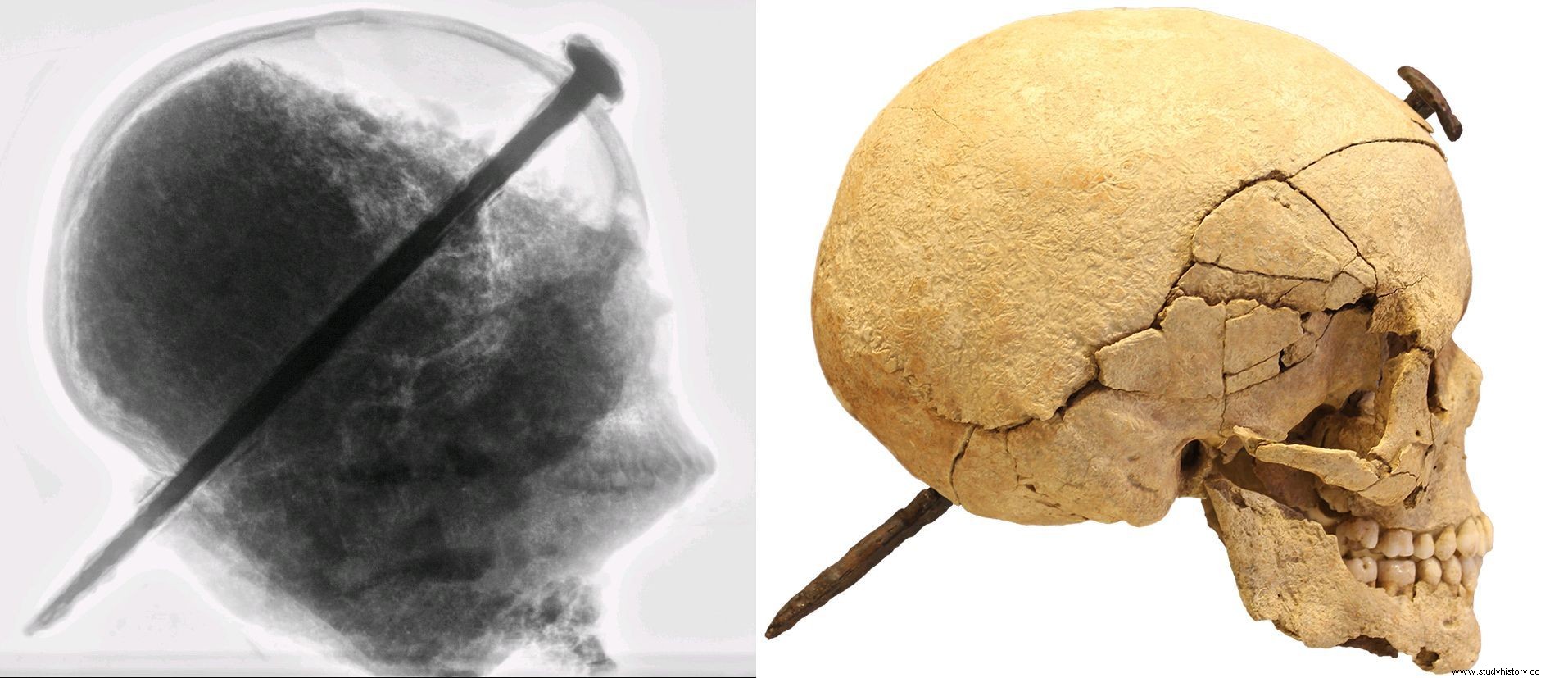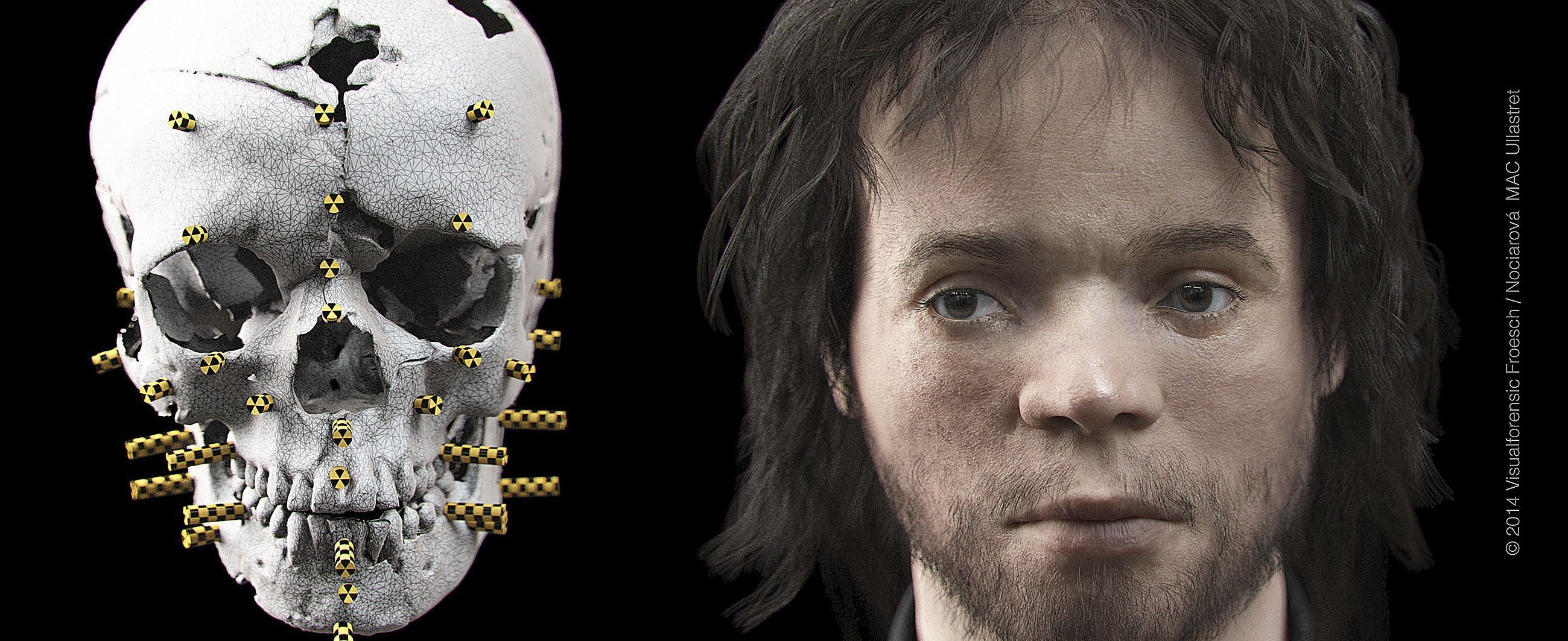
The archaeological site where a greater number of elements related to this ritual practice have been recovered has been in the Iberian city of Ullastret (formed by the settlements of Puig de Sant Andreu and l'Illa d'en Reixac), capital of the tribe of the indiketes . The two sites that make up this large agglomeration, excavated since 1947, have provided more than forty individuals identified from the remains of jaws, skull-maxillae and isolated teeth. The first time human remains of this type were recognized was in 1969, when a silo was excavated from Puig de Sant Andreu, near one of the wall's postern gates. Inside it appeared a deposit consisting of three skulls of adult men along with a mutilated sword. In the same site, cranial remains have also been documented in other silos, in a cistern and around some of the doors of the oppidum. However, the largest group corresponds to the one found in an aristocratic building located in the central-western part of the habitat. During its excavation, numerous cranial remains were recovered along with mutilated weapons (La Tène-type swords and spears) with indisputable signs of violence and interlocking. It is evident that all of them were exhibited in open and visible places:facades, entrances, patios and porches.

In most cases of Ullastret, it can be seen how the cranial bones are altered as a result of long exposure to the elements during the skeletonization process. There are cases in which peri-mortem decapitation marks are observed and ritual actions peri-mortem and postmortem . Some specimens have both types of lesions. In the first group, transverse cuts are detected at the base of the chin and skull. They were necessarily practiced with a heavy cutting instrument wielded with considerable force to cut through the bone. In the second group, vertical incisions are observed in areas of the skull where muscles are inserted and which, based on their location and direction, can be determined to have been made once the head was already separated from the body. Also included in this same group are shallow, parallel incisions made during the scalp skinning process. Numerous remains also present a vertical perforation made by an iron nail that passes through the skull. This last action was always carried out when the head had already separated from the body. In some cases, before trepanning it, the bone was prepared by lowering it with an iron tool so as not to fracture the skull at the moment of impact. All this procedure was done in order to expose the heads in a visible place.

In 2012, various archaeological interventions were carried out in Puig de Sant Andreu (Ullastret) in order to verify results obtained through previous geophysical surveys carried out by the Deutsche Archäologische Institut . The excavations made it possible to document a section of a main street of the settlement, on the roadway of which various human cranial remains rested in an exceptional state of preservation. Indeed, 15 fragments were identified that, once reconstructed and studied in the laboratory, it was possible to certify that they corresponded to 5 individuals. Their proximity to the entrance of a large building suggests that they would have been exposed on their exterior façade for some time at the end of the 3rd century BC. and/or early 2nd century BC

The extraction of these cranial remains was done with the greatest possible precaution, together with the land that surrounded them, with the aim of obtaining as much information as possible. To this end, a multidisciplinary team of researchers was formed and a study protocol was established that contemplated the consolidation, reconstruction and anthropological and analytical study of the remains. This long process began with the performance of various diagnostic imaging tests (3D Computerized Axial Tomography and digital radiography), which made it possible to obtain a precise view of the remains in their blocks of earth and to carry out a first evaluation of the state of conservation of the same to program its consolidation, restoration and study in the laboratory.

Anthropological studies have made it possible to determine basic aspects such as the estimated age at which different individuals died and have provided details about the diseases and injuries suffered in life. Detailed observation of the bones revealed injuries (cuts and blows) caused during violent conflicts in which they were the protagonists, as well as marks caused during handling after their death to transform and prepare the remains for display. At the same time, in specialized laboratories, DNA, stable isotope and other analytical tests have been carried out in order to determine the identity of the human remains, possible family ties, origin and obtain data on their diet. In addition, based on the images obtained by CT, and considering age and sex, a facial reconstruction of the best preserved skull has been carried out, recovering in a fairly approximate way the original appearance of this individual.

In short, most of the human remains that appeared in Ullastret show traces of violence on the one hand and of post-mortem treatment. on the other, so it is reasonable to attribute them to enemies killed in combat, later exhibited as trophies in public and highly frequented places in the city. This practice is in perfect agreement with classical texts that refer to the ritual display of severed heads practiced by some Celtic peoples such as the Gauls. The historian Posidonius of Apamea (ca. 135-51 BC), for example, recounted that once the combat was over, the severed heads of their enemies were hung on the necks of their horses to be taken to their villages in order to display them publicly in the entrances of their houses.

Bibiana AGUSTÍ Archaeoanthropologist, In SITU S.C.P.
Ferran CODINA Archaeologist, Museum of Archeology of Catalonia-Ullastret
Antonia DÍAZ-CARVAJAL Archaeoanthropologist, In SITU S.C.P.
Laura LARA Restorer Museum of Archeology of Catalonia-Girona
Gabriel DE PRADO Archaeologist, Museum of Archeology of Catalonia-Ullastret
Carme ROVIRA Archaeologist, Museum of Archeology of Catalonia
Maria Eulàlia WILL GO UP Researcher Biological Anthropology Unit , Autonomous University of Barcelona
BIBLIOGRAPHY
AGUSTÍ, B., MARTIN, A. (2006):Acts of violence in the Iberian period. The Cas d'Ullastret and other Catalan towns, Cypsela, 16 , Museum of Archeology of Catalonia–Girona, 55-68.
CIESIELSKI, E.; DUDAY, H.; GIRARD, B.; ROURE, R.; MARTINA.; AGUSTÍ, B. (2011):La pratique des têtes coupées et les dépôts d'armes en Gaule méditérranéene et dans le nord-est de la péninsule Ibérique, dans Roure, R.; Pernet, L. 2011 (ed.):Des rites et des hommes. Les pratiques symboliques des Celtes, des Ibères et des Grecs en Provence, en Languedoc et en Catalogne . Eds. Errance, collection Archéologie de Montpellier Agglomeration AMA 2:113-163.
ROVIRA, M.C. (1999):Trophy weapons in Iberian culture:patterns of identification and interpretation, Gladius 19, CSIC-Instituto Histórico Hoffmeyer-Institute of History, 13-32.
